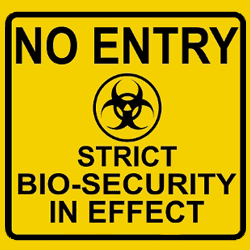[grid-2-3]
 Is biosecurity a cultural norm on your farm? If it isn’t, then you’re not fully protecting your investment. There is ample evidence that biosecurity works. There is a threefold risk of campylobacter on broiler farms if there is no physical barrier between clean and dirty areas in the barn entrance, and an outbreak is 5 times less likely to happen if workers regularly wash their hands, wear dedicated farm boots, and use a foot bath.
Is biosecurity a cultural norm on your farm? If it isn’t, then you’re not fully protecting your investment. There is ample evidence that biosecurity works. There is a threefold risk of campylobacter on broiler farms if there is no physical barrier between clean and dirty areas in the barn entrance, and an outbreak is 5 times less likely to happen if workers regularly wash their hands, wear dedicated farm boots, and use a foot bath.
Encouraging a culture of biosecurity on the farm requires consistency and positive example setting. Being by outlining your specific biosecurity protocols and creating physical barriers and reminds – wash stations, benches for footwear changes. Set the example for biosecurity and insist all visitors, family, friends, and workers follow the same protocols every time.
Some common practices to implement:
Limit visitors and visitations
Restrict visitors to the farm to those who must necessarily be there, and avoid visiting other farms. Disease microorganisms can easily be transferred vie shoes, clothing, and vehicles or equipment. Wear coveralls when visiting other farms and require visitors wear them when at your farm. Wash vehicles or equipment before or upon entry to other farms, or returning to your own.
Keep pets and other animals out of the barn
 Dogs and cats can be carriers of disease if they’ve been exposed to other animals or birds that are contaminated. Keep houses as closed as possible to wild birds or rodents – common carriers of disease – do not gain access to the barn.
Dogs and cats can be carriers of disease if they’ve been exposed to other animals or birds that are contaminated. Keep houses as closed as possible to wild birds or rodents – common carriers of disease – do not gain access to the barn.
Control rodents and pests
Rats, mice, insects, beetles, and flies all carry and spread microorganisms. Clean up feed spills, keep grass mowed, use bait traps or spray where and when necessary.
To learn more about building a culture around biosecurity, read this.
To learn more about biosecurity practices on the farm, read this.
[/grid-2-3]



